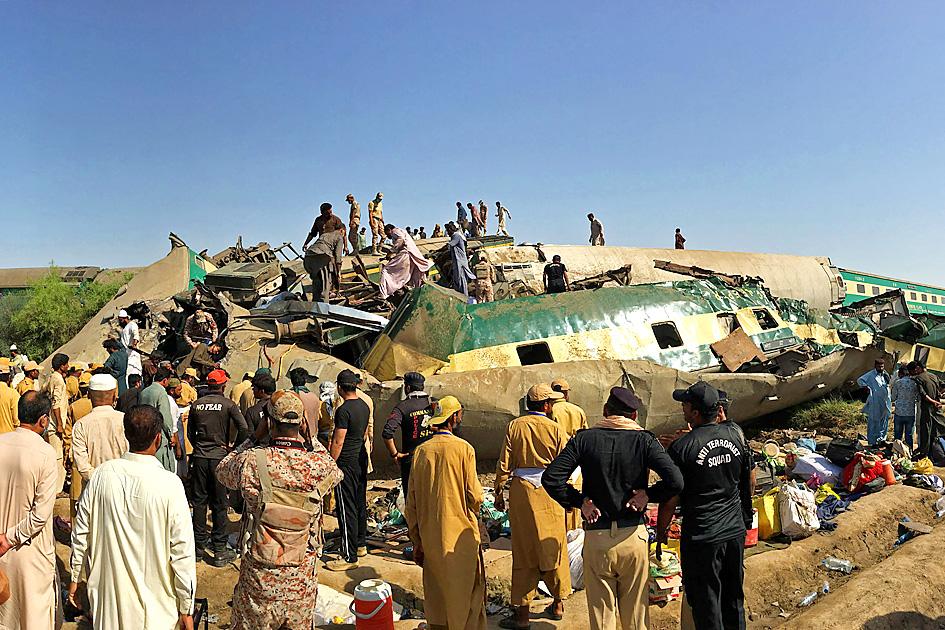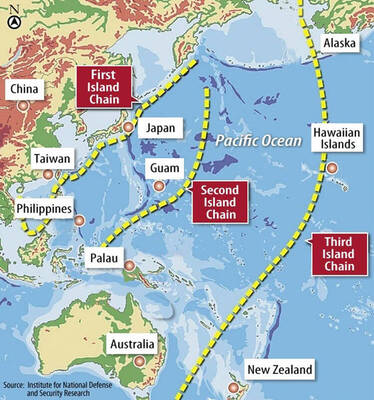At least 40 people were killed and dozens injured yesterday when a packed Pakistani inter-city train plowed into another express that had derailed just minutes earlier, officials said.
Several people were still trapped in the mangled wreckage near Daharki, in a remote part of rural Sindh Province that it took rescue workers with specialist equipment hours to reach.
The double accident happened at about 3:30am when most of the 1,200 passengers aboard the two trains would have been dozing.

Photo: AFP
“We tumbled upon each other, but that was not so fatal,” said Akhtar Rajput, a passenger on the train that derailed. “Then another train hit us from nowhere, and that hit us harder. When I regained my senses, I saw passengers lying around me, some were trying to get out of the coach.”
The Millat Express was heading from Karachi to Sargodha when it derailed, spilling carriages onto the track carrying the Sir Syed Express from Rawalpindi in the opposite direction.
Pakistani Minister for Information and Broadcasting Fawad Chaudhry said that the incidents were just minutes apart.
“I was disoriented and trying to figure out what happened to us when the other train hit,” said Shahid, another passenger.
Daharki senior police officer Umar Tufail said that 40 people were killed and dozens injured.
“One coach is under the engine and we can see three bodies trapped inside,” Tufail said. “Two other bodies have been reported elsewhere, too, so we fear that the death toll will rise.”
A clip aired on a local TV channel showed medics giving an intravenous drip to a conscious passenger whose lower torso was trapped between crushed carriage benches.
Local farmers and villagers were the first at the site, with huge crowds gathering around the carnage and some clambering on top in an attempt to reach survivors.
The dead were laid out in rows on train seat benches and covered in traditional scarves.
The accident happened on a raised section of track surrounded by lush farmland.
Pakistani Minister for Interior Sheikh Rashid, a former minister of railways, said the track where the accident occurred was built in the 1880s, describing it as “a shambles.”
A senior police official said that he had warned authorities about the “dangerous condition” of the tracks and carriages.
The Pakistani army and paramilitary rangers from nearby bases were at the site helping with rescue efforts.
Pakistani Prime Minister Imran Khan said that he was “shocked” by the accident and promised to hold a full inquiry.
Gul Mohammad, who works with the Edhi Foundation ambulance service that was helping move dead bodies away from the site, said communication problems were hindering the coordination of rescue efforts.
“I am talking to you as I stand on the rooftop of my ambulance for better signal,” he said.
Rail accidents are common in Pakistan, which inherited thousands of kilometers of track and trains from former colonial power Britain, but the network has seen decades of decline due to corruption, mismanagement and lack of investment.
More than 300 people were killed and 700 injured in 1990 when an overloaded 16-carriage inter-city train crashed into a stationary freight train near Sukkur, while at least 75 people died when a train caught fire while traveling from Karachi to Rawalpindi in October 2019.

The US government has signed defense cooperation agreements with Japan and the Philippines to boost the deterrence capabilities of countries in the first island chain, a report by the National Security Bureau (NSB) showed. The main countries on the first island chain include the two nations and Taiwan. The bureau is to present the report at a meeting of the legislature’s Foreign Affairs and National Defense Committee tomorrow. The US military has deployed Typhon missile systems to Japan’s Yamaguchi Prefecture and Zambales province in the Philippines during their joint military exercises. It has also installed NMESIS anti-ship systems in Japan’s Okinawa

‘WIN-WIN’: The Philippines, and central and eastern European countries are important potential drone cooperation partners, Minister of Foreign Affairs Lin Chia-lung said Minister of Foreign Affairs Lin Chia-lung (林佳龍) in an interview published yesterday confirmed that there are joint ventures between Taiwan and Poland in the drone industry. Lin made the remark in an exclusive interview with the Chinese-language Liberty Times (the Taipei Times’ sister paper). The government-backed Taiwan Excellence Drone International Business Opportunities Alliance and the Polish Chamber of Unmanned Systems on Wednesday last week signed a memorandum of understanding in Poland to develop a “non-China” supply chain for drones and work together on key technologies. Asked if Taiwan prioritized Poland among central and eastern European countries in drone collaboration, Lin

NO CONFIDENCE MOTION? The premier said that being toppled by the legislature for defending the Constitution would be a democratic badge of honor for him Premier Cho Jung-tai (卓榮泰) yesterday announced that the Cabinet would not countersign the amendments to the local revenue-sharing law passed by the Legislative Yuan last month. Cho said the decision not to countersign the amendments to the Act Governing the Allocation of Government Revenues and Expenditures (財政收支劃分法) was made in accordance with the Constitution. “The decision aims to safeguard our Constitution,” he said. The Constitution stipulates the president shall, in accordance with law, promulgate laws and issue mandates with the countersignature of the head of the Executive Yuan, or with the countersignatures of both the head of the Executive Yuan and ministers or

BACK TO WORK? Prosecutors said they are considering filing an appeal, while the Hsinchu City Government said it has applied for Ann Kao’s reinstatement as mayor The High Court yesterday found suspended Hsinchu mayor Ann Kao (高虹安) not guilty of embezzling assistant fees, reducing her sentence to six months in prison commutable to a fine from seven years and four months. The verdict acquitted Kao of the corruption charge, but found her guilty of causing a public official to commit document forgery. The High Prosecutors’ Office said it is reviewing the ruling and considering whether to file an appeal. The Taipei District Court in July last year sentenced Kao to seven years and four months in prison, along with a four-year deprivation of civil rights, for contravening the Anti-Corruption